This brief guide talks about what Google’s Featured Snippet is, and how you can create content that will stand a chance of getting featured.
Have you ever heard #0 position on Google search results?
Though you might not have heard about it, you must have seen search results ranking on #0 position.
If you search on google.co.in for ‘seo packages’, here is what ranks on the top.

My friend, you must have noticed that it is not a regular search result. The same type of result you will get if you google for ‘one way link’.
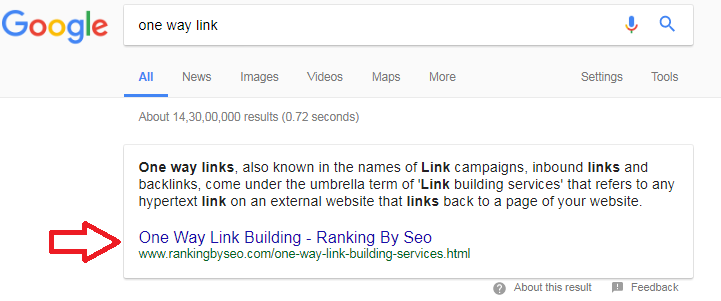
Both the results are different from regular search results and referred as Google’s Featured Snippets. As they appear on the top, right above the SERP results, we call them search results ranking on #0 position.
Do you want your content to appear in Google’s Featured Snippets?
In today’s post, I am going to discuss how to write content that will stand a chance of appearing on #0 position.
Before coming to that, let us first discuss in detail:
What Is Google’s Featured Snippet?
When someone asks a question in Google Search, Google often times shows a search result in a block at the top of the search results page. This specially featured snippet is a summary of the answer, extracted from the same web page.
As you can observe in the featured snippets of Ranking By SEO, the page title along with URL of the page also accompanies a Google’s featured snippet.
Now, a question comes,
Where does a Google’s Featured Snippet come from?
Google programmatically extracts the summary from a web page to show visitors. It is not necessary that Google will only show Google’s Featured Snippets when someone asks a question. Google also shows featured snippets that can be the best possible answers to the queries of searchers.
You can also opt out of featured snippets by adding <meta name=”googlebot” content=”nosnippet”> tag to your page.
Why You Should Care About Google’s Featured Snippets
Are Google’s Featured Snippets helpful?

The answer is a big resounding YES.
Here are the top reasons why you should care about Google’s Featured Snippets:
- When your business appears in Google Featured Snippets, searchers see you on the top. This builds trust and credibility.
- You rank on #0 position even if you appear on the third or fourth position in the search results. This boosts click through rate (CTR).
- As Google’s Featured Snippets are prevailing more often these days, you cannot afford to do nothing.
According to HubSpot,
“For high traffic keywords, ranking in the Featured Snippet saw an average increase in CTR of over 114%.”
Do you still need more reasons to care about getting featured?
A Few Observations about Google’s Featured Snippets
How does Google choose web pages for featured snippets?
Well, no one exactly knows. However, we can examine the data and come to an intelligent guess.
I have analyzed a considerable number of Google’s Featured Snippets and observed the following important facts.
Organic Search Ranking Alone Does Not Feature a Snippet
Though Google often picks snippets from the top 1-3 results, it is not always true. Sometimes, Google chooses results from 4-5 positions as well.
If you google for ‘on page seo factors’, you get this Google’s Featured Snippet:

SEMrush’s blog appears in Google’s Featured Snippet, but it does not rank on any of the top three positions.
In fact, SEMrush ranks on the fifth position.

I have also observed a few results featuring from the second page of Google search results.
So, we can say that organic search ranking alone does not ensure that a search result will feature.
Snipp-able Content Has More Chances for Featuring
Needless to say, Google wants to provide the searchers with the most clear, concise, and thorough answer. This means Google is always looking for Snip-able content.
Let us analyze these two Google’s Featured Snippets for the keyword ‘content marketing plan’ and ‘social media promotion strategy’

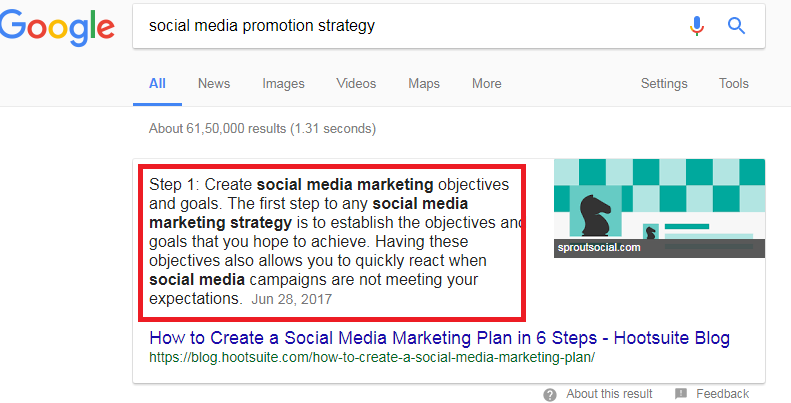
Both the snippets have around 40-50 words. SEMrush has analyzed 10 million keywords and 1 million domains. It has found that the most common length of content in Google’s Featured Snippets is between 40-50 words.
Engagement Metrics Has a Powerful Role
Yes, my friend, engagement plays an important role in getting picked by Google. Larry Kim has analyzed around 50 pages of his website, WordStream, and found that engagement metrics affect the chances of a web page getting featured.
Larry said in his article on Moz,
“What I found was that the relative time on site for pages that were snipped from low positions on the SERP has incredibly higher time on page, compared to the site average.”
After analyzing more than a thousand Google’s Featured Snippets, I have found that content has the most important role in getting picked by Google. The content on your web page must be clear, unique, and through to answer the queries of searchers.
How can you write content that stands a chance of getting picked by Google for featured snippets?
I will discuss it here. But before that,
Important Disclaimer about Google’s Featured Snippets
Google’s Featured Snippets are not easy to decode. There are many reasons. The most important one is the lack of access to data. You can analyze the content structure of the featured snippets, but the detailed analysis can be done only when you have access to those Webmaster accounts, which cannot be possible.
So, we have to work with limited data and make an intelligent guess based on the data we have. There is no hard-and-fast rule. You have to give your best shot.
The next, I will discuss the type of content that, I have often found, appears in Google’s Featured Snippet.
How to Write Content That Appears in Google featured Snippets
As featured snippet box is available to everyone who can create useful content, the competition is tough. You need to work hard to get there. Here are a few simple ways that have helped me get my content rank on #0 position.
Here are a few simple ways that have helped me get my content rank on #0 position.
1- Know the Questions Your Audience Is Asking
Eric Enge at Stone Temple has conducted research and found that 19% of searches starting with questions result in Google’s Featured Snippets.
Usually, search terms begin with one of the following phrases:
- How does
- How do
- How to
- What is
- Why do
- Why does
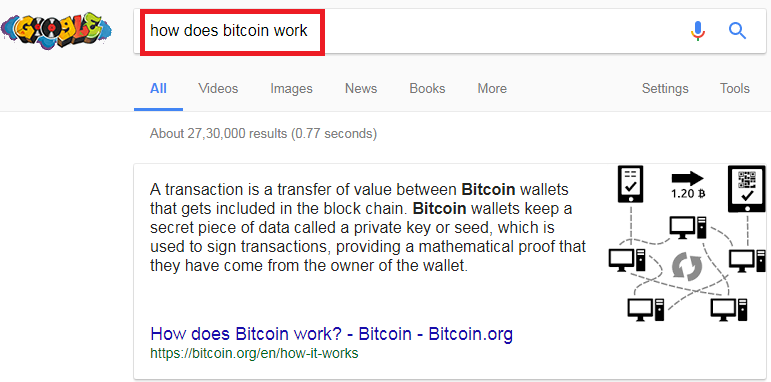

The best way to match your content to the queries of searchers is to focus on long-tail keywords.
For example:
If you want to write an article that is focused on content marketing, you should consider using long-tail keyword, such as ‘how to create content marketing plan’ or ‘how to create a successful content marketing strategy’.
Now, you must be thinking that how you will choose long-tail keywords.
Just type ‘content marketing how to’ in Google Search Box, you will get suggestions that would be the excellent topics for the next content.
Here are the screenshots that will explain the entire process.

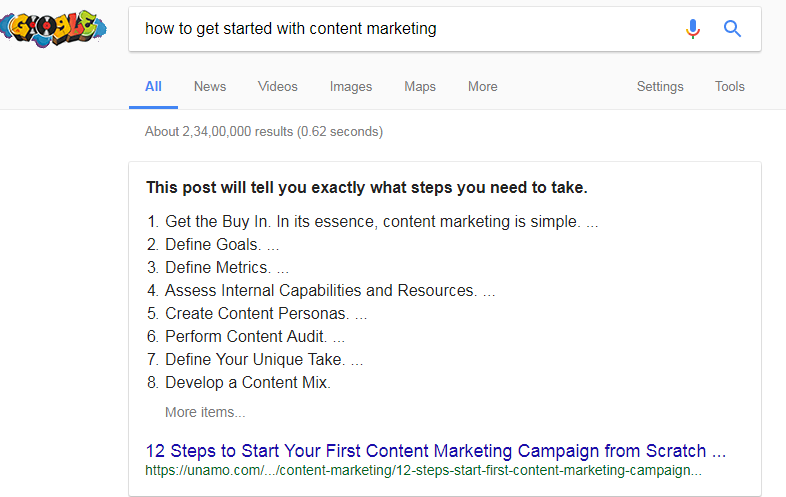
2- Craft Content That Answers Questions
The whole concept of Google’s Featured Snippets is to provide the best answers to searchers’ queries. You should craft content in a way that it should answer the queries of your audience. Only then, you will stand a chance of ranking on #0 position.
As rightly pointed out by Neil Patel in his article,
“If your content doesn’t answer questions, it won’t get into the featured snippet. That’s all there is to it.”
Let us analyze the Google’s Featured Snippet for the keyword, ‘how to book an uber cab’:
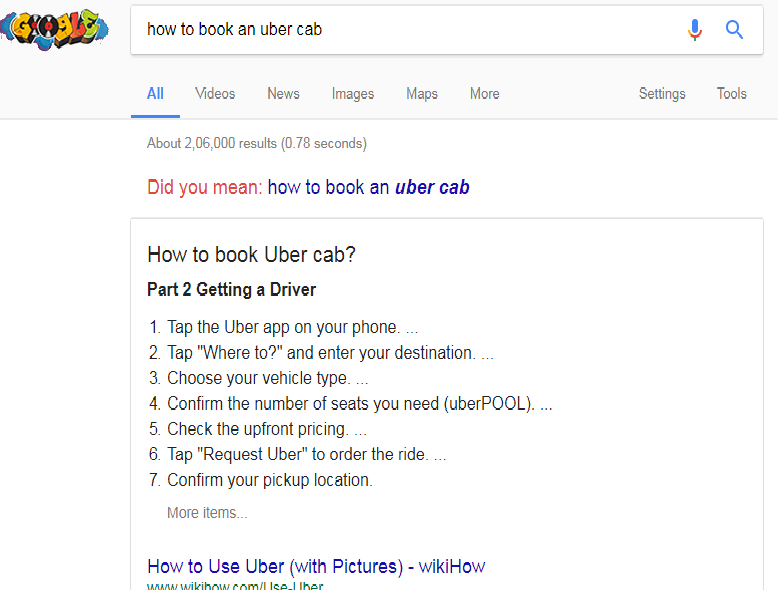
The content of wikiHow explains the process step-by-step.
3- Create High-Quality Content
The main objective of Google’s Featured Snippets is to offer clear, concise answer. This simply means you need to create high-quality content.
Here are a few tips on writing high-quality content that is more likley to get featured:
- Break down the content into small parts
- Use lots of media (screenshots, infographics, etc.)
- Explain a process in simple steps
- Write in way that even a beginner can grasp the topic
- Write user-focused content
The bottom line is,
You should write the content that answers searchers’ queries.
4- Use Question and Answer Pages
Needless to say, Question and Answer pages have more chances to make it to featured snippets.
Reason?
These sections are already addressing the questions of your target audience.
However, you should make sure that Question and Answer pages have all the relevant information your target audience might be searching for.
Dig deeper into the topic, and cover all the questions related to the topic.
Conclusion:
Getting content appeared in Google’s Featured snippet is difficult, but not impossible. If your content answers to searchers’ questions, your chances to get featured will increase by many folds.
What about you? Do you have web pages that appear in Google’s Featured Snippets? If yes, then do share your insights. I would love to know about it.

